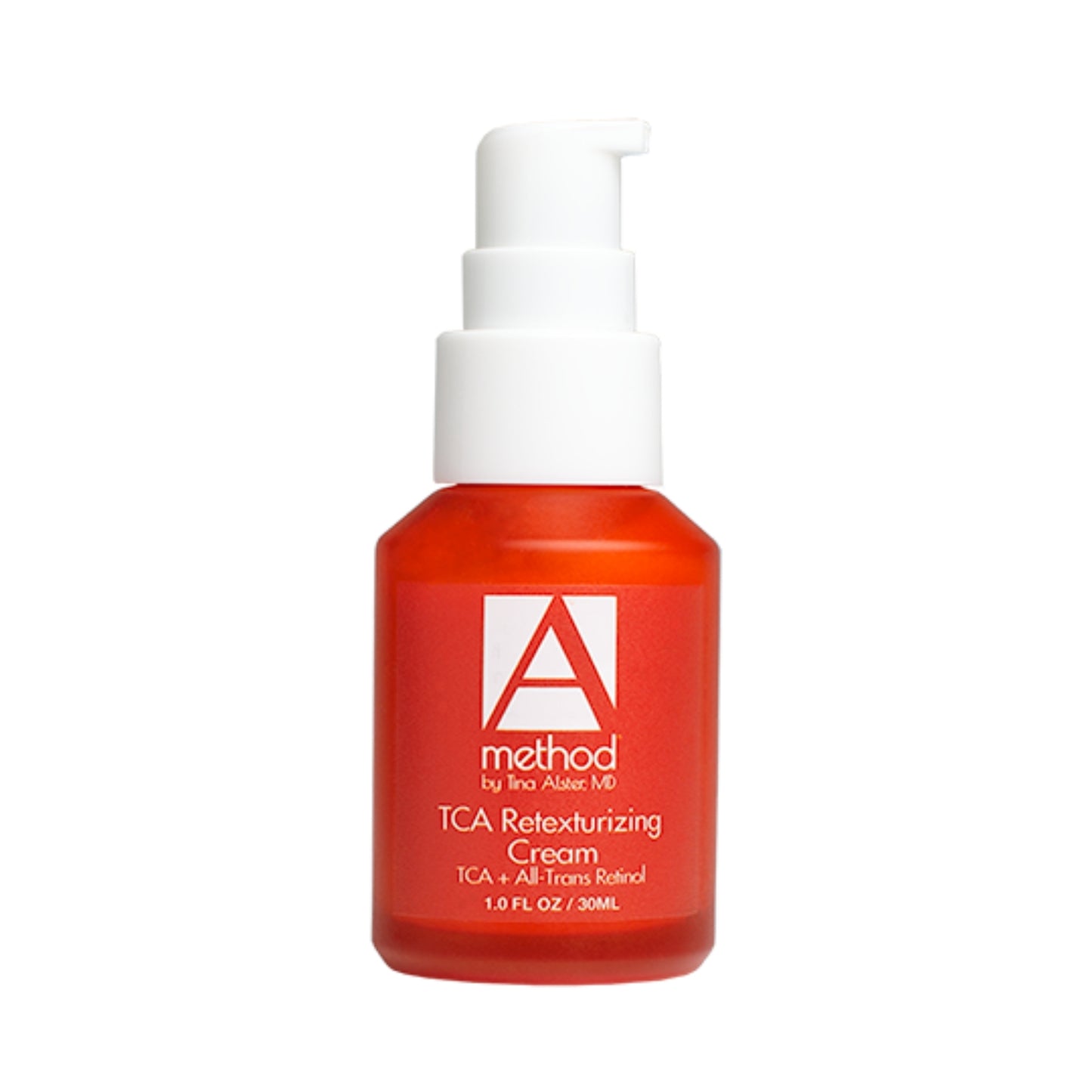TCA Retexturizing Cream
TCA Retexturizing Cream
Description
Restorative formula gently resurfaces, stimulates cell turn over and improves conditions for nourished collagen.
Skin Stimulating All-Trans Retinol Cream
A unique formula combing clinical strength All-Trans Retinol and TCA to gently exfoliate and stimulate conditions for cell turnover. With nightly use, improve smoother skin texture while balancing conditions for clearer, brighter skin. Helps to balance pigmentation concerns and set the stage for even complexion.TCA Retexturizing Cream

In your regimen
In your regimen
- Cleanse
- Step 2: Prep
- Moisturize
- Eye care
- Protect
Apply to face, neck, and décolleté at night daily after cleansing.
Targets
Targets
Dull complexion, uneven pigmentation and signs of degraded collagen production.
Suited for
Suited for
PM • All Skin Types
Key Benefits
Key Benefits
- Formulated with All-Trans Retinol and TCA
- Helps improve the look of uneven skin texture and tone
- Gently resurfaces skin to reveal fresher, more vibrant complexion
- Hydrating formula restores the skin's moisture balance
- Suitable for use on arms, legs, and hands to address texture concerns
INGREDIENTS
INGREDIENTS
Water, Trichloroacetic Acid, Glyceryl Stearate, PEG-100 Stearate, Cetearyl Alcohol, Ceteareth-20, Dimethyl MEA, Isopropyl Palmitate, All-Trans Retinol, Polysorbate 20, Cetyl Alcohol, Squalane, Butyrospermum Parkii (Shea) Butter, Sodium Hyaluronate, Disodium EDTA, Zinc Sulfate.
Couldn't load pickup availability
-
 Free Shipping On orders Over $75.00
Free Shipping On orders Over $75.00
-
 Fast Delivery Quick Fulfilment
Fast Delivery Quick Fulfilment
-
 Sign Up & Save Mailing List Perks
Sign Up & Save Mailing List Perks
Share



FAQs: TCA Cream (TCA Retexturizing Cream by The A Method)
Reveal smoother skin texture and more balanced tone with The A Method’s TCA Retexturizing Cream.
Formulated with a clinical-strength blend of All-Trans Retinol and trichloroacetic acid (TCA), this nighttime TCA cream gently exfoliates dead skin cells, supports natural turnover, and improves the appearance of fine lines, dry and aging skin. Hydrating and restorative, it’s suitable for all skin types, including sensitive skin.
What is TCA Retexturizing Cream used for?
What is a trichloroacetic acid cream?
What does TCA do to the skin?
Is TCA Retexturizing Cream safe for daily use?
How do I apply TCA Retexturizing Cream correctly?
Should I expect peeling or irritation when using TCA?
Is sunscreen necessary when using TCA Retexturizing Cream?
Can I use TCA Retexturizing Cream with other active ingredients?
Who should use TCA Retexturizing Cream?
Does TCA Retexturizing Cream help with skin discoloration or uneven tone?
How long does it take to see results from TCA Retexturizing Cream?
Can sensitive skin types use TCA Retexturizing Cream?
Can I use this product during the day or only at night?
Is TCA Retexturizing Cream available over the counter?
What should I avoid while using TCA Retexturizing Cream?
- Don’t apply on broken or irritated skin
- Avoid harsh exfoliants or scrubs
- Skip strong acid-based peels unless specifically advised
- Limit sun exposure and always wear SPF
- Keep the product away from your eyes
If accidentally swallowed, do not induce vomiting. Contact a poison control center or your healthcare provider right away.
Can I use this product if I’m pregnant or breastfeeding?
Retinol is generally not recommended during pregnancy due to its known risks to fetal development.
TCA may be used with caution in some professional settings during pregnancy and is typically considered safe during breastfeeding, but guidance can vary. Your provider can help you determine what’s appropriate based on your skin needs and health history.
How should I build a skincare routine for aging skin?
Key ingredients to look for
- Hydrating ingredients: Moisturizers with sodium hyaluronate, mineral oil, seed oil, or xanthan gum help support moisture balance and soften the appearance of fine lines.
- Active ingredients: Look for products with vitamin C, All Trans Retinol, or gentle acids like lactic acid or glycolic acid to improve skin texture and tone.
- Supporting ingredients: Additives like disodium EDTA (a stabilizer), potassium sorbate (a preservative), and sodium benzoate (an antimicrobial agent) help maintain a product’s shelf life, texture, and effectiveness.
Best practices for application and safety
- Start slow: Begin with lower concentrations of retinol or acids 2–3 times per week. Increase gradually as your skin builds tolerance.
- Prep properly: Always start with clean skin. Wash and dry thoroughly before applying products to your face, neck, or other areas.
- Layer with caution: Avoid combining multiple strong actives, and keep products away from the eyes, broken skin, and sensitive areas.
- Time your products right: Use vitamin C in the morning for antioxidant support, and reserve retinol or resurfacing products for nighttime use.
- Follow directions: Always follow the label’s specific instructions, especially for products containing acids or pH adjusters like sodium hydroxide.
- Protect your skin from sun damage: If using exfoliating products, a broad-spectrum sunscreen is essential to protect your results and prevent damage from sun exposure.
- Introduce products gradually: Cleanse, rinse, and introduce one new active ingredient at a time. This makes it easier to determine what works best for your skin.
Extra tips for aging skin
- Apply hydrating serums to slightly damp skin to help ingredients like hyaluronic acid bind moisture more effectively.
- For the delicate eye area, opt for specialized creams with peptides or caffeine. These are gentler and better suited for thinner skin.
- Results from anti-aging ingredients typically take 6-12 weeks to show, so stick with your routine.
- When in doubt, consult a skincare professional, especially if you have sensitive skin or are new to products like retinol or TCA.
Still have questions?
Recently Viewed
- Choosing a selection results in a full page refresh.
- Opens in a new window.









